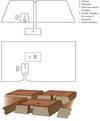Ancient Egypt Flashcards
Ancient Egypt
- advanced medicine and knowledge of anatomy
- artists were vry talented and capable of representational work
- obsessed wth afterlife
- connectedness to the nile
- post-lintel architecture still relevant
People, Boats, and Animals
(3,500-3,200BCE/Predynastic)
- wall painting of men boats and animals from the shrine of Hierkonpolis
- earliest known ancient Egyption mural painting, in part depicting afterworld

Mastaba
- Egyptian tomb
- above ground chambers

Palette of Narmer
(3,000-2920BCE/Predynastic Egyptian)
-Earliest Restored historical relief, showing unification of Upper and Lower Egypt

Khafre from Gizeh
(2,520-2,494 BCE/fourth Dynasty)
- depicts pharoh as divine enthroned ruler
- idealized body in eterna stillness appropriate to afterworld

Stepped Pyramid of king Zozer
(2,630-2,611 BCE/Old Kingdom/Third dynasty)
- resembles a series of stacked mastabas diminishing in size
- used as mortuary
- created by first known artist, Imhotep

Pyramids of Gizeh
(2,490-2,472 BCE, Menkaure)
(2,551-2528 BCE Khafre)
(2,551-2,528 BCE Khufu)
(Ancient Egyptian-Old Kingdom)
-each pyramid is a part of a vast funerary complex

Portrait of Sensuret III
(1,860 BCE/Middle kingdom)
-displays an unprecedented psychological realism during period of political instability

Funerary Temple of Queen Hatsheput
(1,473-1,458 BCE/New Kingdom)
- commissioned by feamle pharaoh
- structure incorperates ritualistic processional path leading from nile to inner cliff

Akhenaton
(1353-1335 BCE/New Kingdom)
- reflecting his leadership of hew monotheistic religion.
- this image may be an attempt to portray the pharoh as atton, the sexless sun disk



